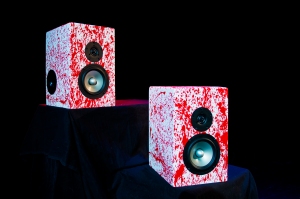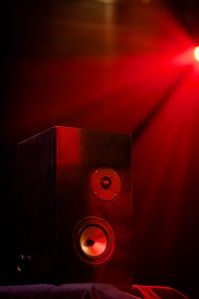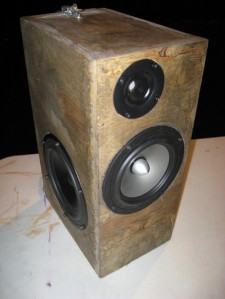Archive
Model: BOSSA NOVA

Construction and Tuning by Aidan Conrade
These are assembled realizations of the Samba MT Loudspeaker Kit, found on Parts Express. After going through what I wanted out of a loudspeaker and how much money and time I had to work with, I was approved to choose a solid knock-down kit with drivers and a passive crossover to build! I built them to be flexible since I want to do many things with them, so they can handle mixing, instrument monitoring for my bass guitar, and a good listening experience for music and television. They are a manageable size since I wanted them to be easy to fit anywhere I need them to be, as well as be easy to move with. I eventually want to hit them with a layer of primer and some nice burgundy water-resistant paint to make them look nice. While they are speaker kits, I wanted to be able to connect with them more and give them a name, and while I was finishing my work on them I came up with the name Bossa Nova, since the original name was Samba MT, and while Bossa Nova is my favorite style of jazz to play it was also derived from the roots of Samba, much like this speaker was derived from the kit I purchased at the start of this adventure!
The Dayton Audio Reference Series drivers carry the performance of the loudspeakers with their consistent frequency response at a budget price. Each speaker kit cost $165, including all of the parts for the passive crossover, and with the fact that I already had cables and an amplifier that could handle them, I only spent ~$350 on them, with a surplus of $20 going to a kind person on eBay who designed PCB’s for the crossovers in these speakers and sold them in pairs with mounting hardware for the board and wire terminals for your cables so you can easily replace cabling inside of your speaker. For those interested in purchasing this kit for yourself, be aware that they do not come with a circuit board for the crossover like the Dayton C-Note kit.
Specifications:
- Dimensions- 15″ x 8.5″ x 11.25″
- Frequency Response-
- ± 3 dB from 60 Hz – 1.2 kHz, a shallow dip from 1.2-4 kHz, and a boost from 4-20 kHz that stays back in the realm of ± 3 dB
- Port gives extra bass extension down to 30 Hz
- Drivers-
- Dayton Audio RS180P-4 7″ Reference Series Paper Cone Woofer
- Dayton Audio RST28F-4 1-1/8″ Reference Series Fabric Dome Tweeter
- Sensitivity- 90.8dB @ 1m
- Power Handling- 60W per cabinet
- Max Power Handling- 90W
- Crossover Frequency- 2.4 kHz
Selected Measurement Graphs:



Technical Paper:
This paper still needs some work and I ran into some tuning and measurement issues so I hope to update this page at a later date and make everything look nicer!
MF 2.1 System
Designed by Matthew Fisher
The MF 2.1 System is designed for music listening and enjoyment. It consists of a pair of Dayton Audio C-Notes and a Dayton Audio 12″ Ultimax Subwoofer, all of which were purchased as kits off of Parts Express. I decided to bypass the passive crossover portion of the C-Notes and design this system as a fully active system to allow for the most efficient and accessible form of control during tuning and playback. I also wired the subwoofer as 2+2 ohm setup, again allowing for greater control over each voice coil.
The construction process was straightforward because these were kits. The decision to design a fully active system removed the necessity for installing passive crossovers and saved on construction time, which allowed for more tuning time. The tuning process focused on a flat response with extended low end to enhance both music listening and mixing. Unfortunately, the limited high frequency response will impact mixing usage, but the overall frequency response works well for enjoyment purposes.
Specifications:
Tweeter: Dayton Audio ND25FW
Woofer: Dayton Audio DSA-135A
Subwoofer: Dayton Audio UM12-22
Cabinet Material: MDF
Dampening Material: Rockwool
Overall Frequency Response:

Overall Horizontal Off-Axis Response:

Documentation:
Vera 8907s

Designed by Zachery L’Italien
Design Goals:
- Pleasurable Listening
- Warm Response
- Stunning Aesthetics
- Portable
Features:
- SB Acoustics SB17CAC35
- SB Acoustics SB29SDAC-C000-4
- MiniDSP PWR ICE 125 Plate Amp
- Rear port for low end response
- Timeless look
Integrated Frequency Response:
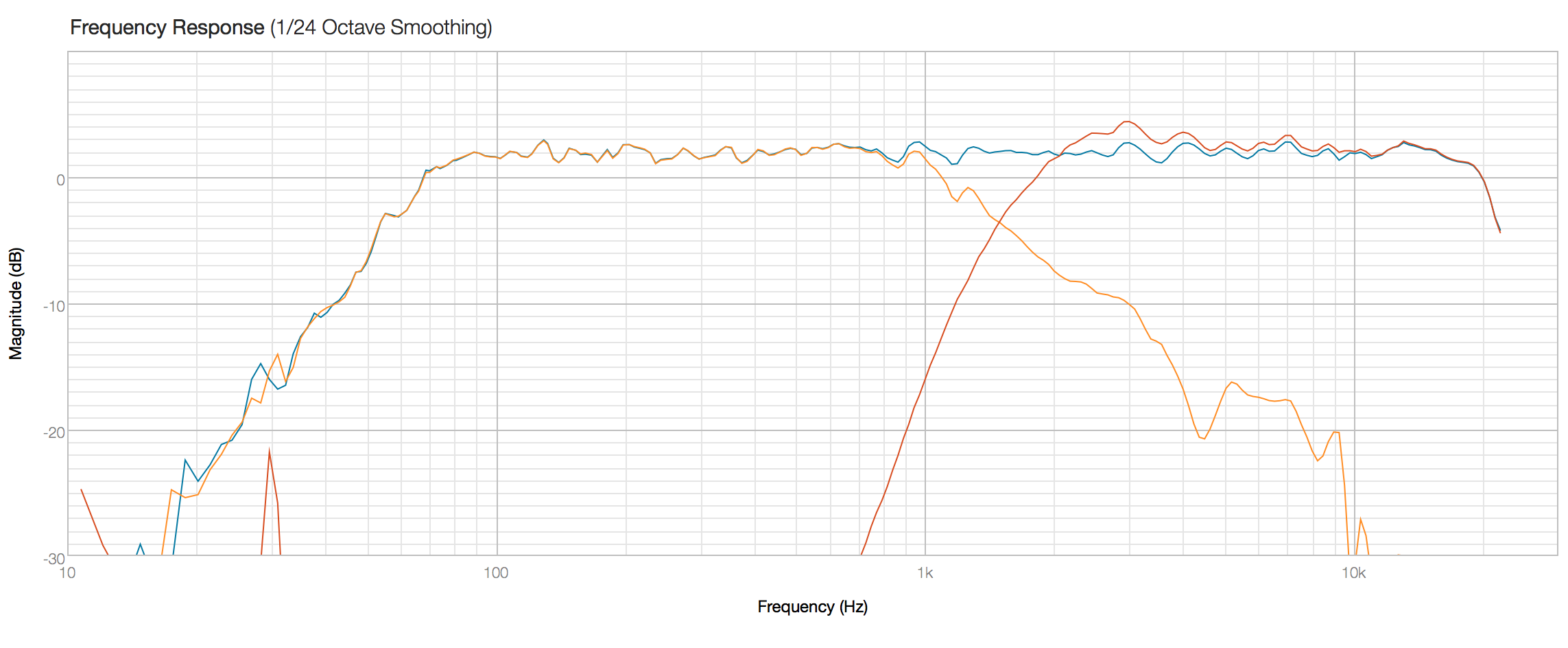
Off-Axis Frequency Response:
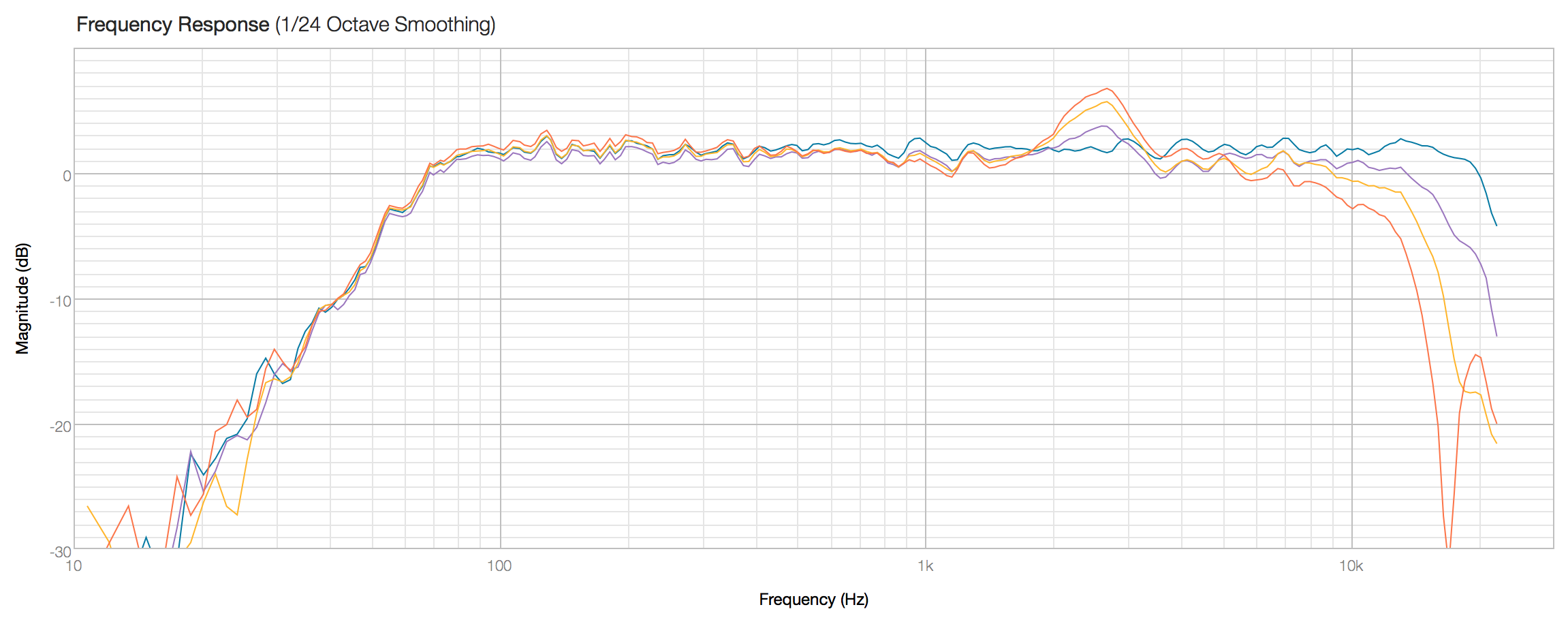
Harmonic Distortion:
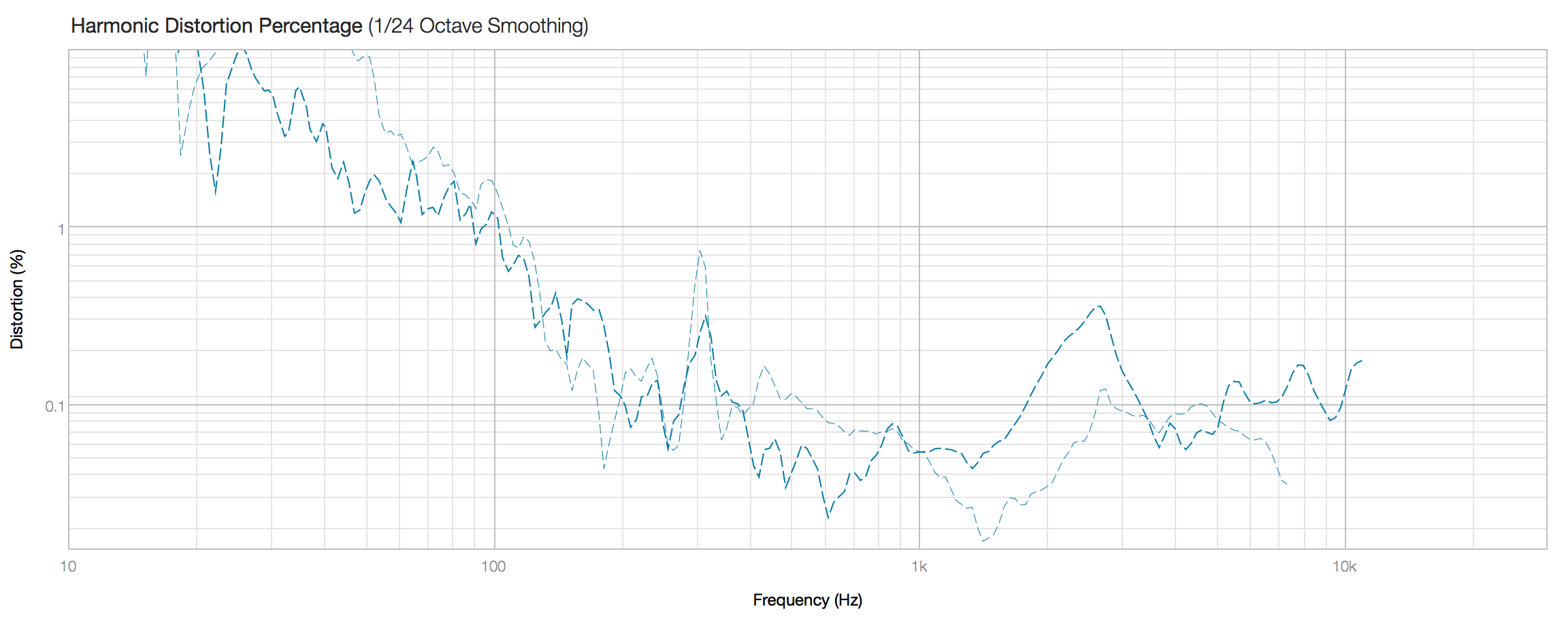
RSS-603 Reverberation Room Testing Speakers
This set of speakers were designed as reference source speakers for testing in reverberation chamber. To be suitable for this condition the set of six speakers need to be able to reach a high sound pressure level with a frequency response of +/- 3dB per ANSI standards. Additionally, due the sound pressure needed at a constant duration, the drivers needed high power handling capabilities. The specific room that these will be installed do not accurately test below 400 Hz so this was taken into consideration in the design.
Tech Specs:
-F3 of 250 Hz
+/- 2.25 dB
Two way digital cross over
Mono for testing capabilities
Drivers:
Woofer: Celestion NTR06-1705B 6-1/2″
Tweeter: Tymphany D27TG35-0
Frequency Response
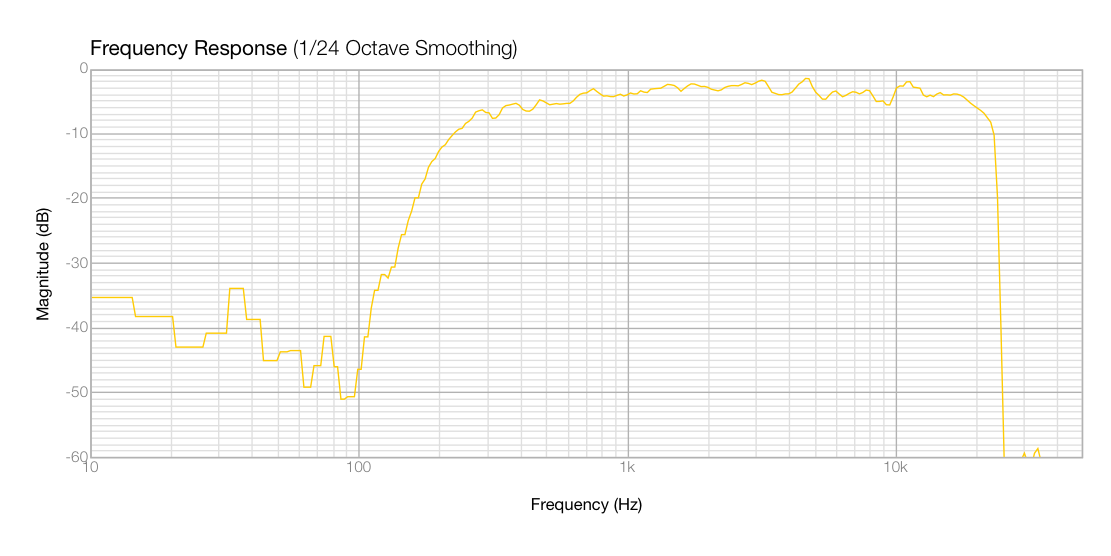
Integrated Frequency Response
The Dark Passengers – 2 Way Ported Nearfields
Designed and constructed by Andrew Villa
Design Goals
- Portable
- Accurate Response
- Hi-Fidelity for creating/mixing SFX, Dialogue, and music
- Tight transients
- Good horizontal Off-axis
- Dexter Themed
- Used as Nearfield monitors
Key Features
- Small size: 12 1/4″ x 10 1/4″ x 16 1/4″
- +/- 1.6 dB from 80 – 20 kHz
- Vented Enclosure = decent bass for small near fields
- Cost $400
- F3 of 72 Hz
- Tight, precise sound
- Great Clarity
- Unique paint design
Drivers
- Fountek FW168 6.5″ Aluminum Cone Woofer
- Vifa XT25TG30-04 1″ Ring Radiator Tweeter
Testing Results
Overall Frequency Response:
Integrated Frequency Response:

Purple: Tweeter, Yellow: Woofer, Blue: Overall Sum
Impulse response:
Documentation
Ignis Series 1
Designed, Built, and Tuned by Jonathan Moths
Design Goals:
- Small size for desktop use
- Low cost ($400-500)
- Primary use is listening for pleasure
- Maximize bass extension despite small size
Features:
- 1″ diameter side port to enhance bass extension
- Portability and small size (9 1/2″ x 9 1/4″ x 1’2″)
- +/- 2 dB from 70 Hz to 20 KHz
- F3 of 60 Hz
- Metal Dome Tweeter
Drivers:
- SB Acoustics SB26ADC-C000-4 Metal Dome Tweeter
- SB Acoustics SBMFC35-4 6 inch Poly Cone Woofer
Documentation:
GDX2
Overview
This 2-way desktop/bookshelf stereo pair was designed to be used for general music listening, as well as mixing. With a ported cabinet, this system has an F3 of around 80 Hz, giving a good representation of bass frequencies without necessarily needing a subwoofer, though one can be used for added fullness. Designed on a budget, this pair cost just under $500, giving high performance at a relatively low cost.
Goals:
- Small size for desktop use, as well as portability.
- Low frequency extension.
- Flat frequency response.
- Budget of $500.
Features:
- 2-way system.
- Passive crossovers.
- Ported cabinet for low frequency extension.
- Flat response curve (variation of 1.5 dB.)
Cabinet:
- 3/4″ 11-ply birch exterior.
- 1/2″ MDF interior.
Drivers:
- SEAS Prestige h1141 5.5″ aluminum cone woofer.
- SEAS Prestige h1211 1″ textile dome tweeter.
Documentation:
Testing Results:
Overall
Frequency Response Curve
Inverted Polarity on Tweeter
Crossover Filter Response
Horizontal Off-Axis Response
Vertical Off-Axis Response
Step Response
Impulse Response
Minimum Phase Plot
Tweeter
Frequency Response
Horizontal Off-Axis
Vertical Off-Axis Response
Tweeter Left/Right Difference
Step Response
Tweeter Impedance
Harmonic Distorion
Woofer
Woofer Frequency Response
Horizontal Off-Axis Response
Vertical Off-Axis Response
Woofer Left/Right Difference
Impulse Response
Woofer Impedance

GDX2 by Grant Prusi is licensed under a Creative Commons Attribution-ShareAlike 3.0 Unported License.
DKS 800
Design Goals
-Full extended frequency response
-Evenness in frequency
-Balance in frequency
Drivers
-Tweeter Audax TW025A8
-Woofer: Silver Flute 8 Wool cone 4 ohm
Materials
-1/4″ MDF
-3/4″ OSB plywood
Documents:
DKS 800 by Daniel Serunjogi is licensed under a Creative Commons Attribution-NonCommercial-ShareAlike 3.0 Unported License.
Green Run: Critical Editing Speakers
What they lack in size they make up in clarity and versatility. Designed for
near-field desktop audio editing, these speakers are created to
reproduce the sound signal with maximum clarity. Optimized and built
small to fit at any editing environment and portable for the nomad
lifestyle.
Design Objectives:
- Bookshelf monitors for audio editing for music, sound effects and film
- Wide frequency range (60 Hz to 20 kHz)
- Smooth frequency response
- Inexpensive
Key Features:
- Small, and portable
- Clear stereo image
- Minimal off-axis coloration
- Low crossover frequency of 1.5kHz
- Under $500
System Response
Final System Response Charts Left Cabinet
Final System Response Charts Right Cabinet
SB Acoustics 29RDCN C-0004
Final Tweeter Response Charts Left Cabinet
Final Tweeter Response Charts Right Cabinet
Fountek FW 146
Final Woofer Response Chart Left Cabinet
Final Woofer Response Chart Right Cabinet

This work is licensed under a Creative Commons Attribution-No Derivative Works 3.0 United States License.







